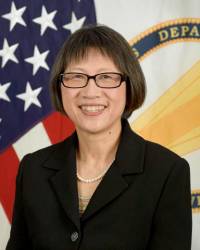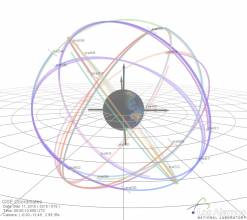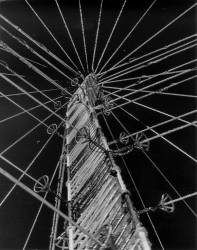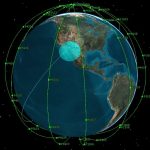A cooperative network of government labs, funded by a hopeful broadband company, is now testing GPS receivers in a surprise program that will draw key federal agencies directly into an argument over GPS interference standards.
A cooperative network of government labs, funded by a hopeful broadband company, is now testing GPS receivers in a surprise program that will draw key federal agencies directly into an argument over GPS interference standards.
The testing program was proposed, framed, and funded by Ligado, a would-be wireless firm that, along with its predecessor, has been at odds with the GPS community for years. Ligado favors an interference standard based on position error and not the internationally accepted standard that uses degradation in C/N0, the ratio between the carrier power of the signal and noise power density.
Ligado has a vested interest in challenging the status quo. It is the successor to LightSquared, which proposed in 2010 to repurpose frequencies in a band set aside for space-to-Earth satellite transmissions, a potentially valuable patch of spectrum neighboring that used by GPS.
LightSquared wanted to use those frequencies for a powerful ground-based broadband network. Tests the following year, however, showed the wireless signals (also called LTE signals) would overload a wide variety of GPS receivers. The FCC put the firm’s plans on hold and LightSquared filed for bankruptcy in 2012, exiting in 2015 with a different set of owners and a new name.
Ligado is now proposing a modified version of the initial plan, saying it will permanently forego using the 10-megahertz of frequencies closest to GPS and dial down the power of its signals.
The company also has been working furiously to convince regulators that they should use a different interference standard to judge if this revised plan will interfere with GPS — which is where the new tests come in.
Margins? What Margins?
The established way of determining if a signal will hamper the functioning of GPS receivers is to look for a one-decibel (1 dB) degradation in C/N0, the carrier-to-noise power density ratio. Ligado, however, is seeking to make position error — that is the error in the location information generated by the receiver — the new yardstick for interference.
Using position error stacks the deck in Ligado’s favor, said Logan Scott, a GPS signal expert and a consultant specializing in radio frequency signal processing and waveform design for communications, navigation, and other systems, in an interview earlier this year.
It’s well known, he said, that GPS receivers can give accurate position information even when experiencing serious interference. As long as they are tracking satellites they can provide fairly accurate positioning information right up to the point where the interference causes them to lose their lock on the satellite.
“By substituting position error for C/N0 degradation you’re basically building in a strong case for LTE,” he said, “in other words allowing very high levels of interference — damaging levels of interference.”
C/N0 is about reliability and safety margins. To ignore it is a bit like measuring how many tires are on the road without taking into account the margin between the car and the ditch. Everything seems fine until you suddenly need a tow truck.
“The interpretation that Ligado has given on all these things basically eats up essentially all of the margin,” Scott said in an interview for this story. That undermines the reliability and robustness of the receivers as well as one’s ability to deal with an impaired environment.
“GPS is very much a safety life system,” said Scott. “Margins are important . . . . You don’t want to use the margin up.”
Testing, Testing
Ligado, however, is earnestly pursuing a position-error standard. To support its case the company contracted with Roberson and Associates, a well-known communications firm, to test the position error of GPS receivers in the presence of Ligado’s signal and compare that to C/N0.
Ligado said that the tests showed its signals were compatible with GPS receivers and that C/N0 was not a useful guide. Moreover, based in part on its position-error standard, it has asserted the interference issues with GPS have been resolved.
The Roberson tests, however, were considerably less than persuasive. Although Ligado insisted the tests showed that GPS receivers were not impacted, even Roberson’s own data, which was released along with their test report, showed some receivers were affected by the signal.
“If you look at the data, you’ll see a reference receiver that’s lost a ton of satellites,” said Scott. “The whole purpose of a reference receiver is to provide information on what’s going on on every satellite that’s in view. When it starts losing satellites, as it did in the Roberson test, there’s been a major impact to the system.”
In comments submitted to the Federal Communications Commission (FCC) May 22, Scott detailed how the Roberson data revealed the reference receiver’s sensitivity to interference from Ligado’s uplink (handset) band. The tests showed “obvious deterioration” to C/N0 at –45 dBm, he wrote, and that the receiver was losing satellites by –34 dBm. Position error, however, was not affected until –24 dBm.
Tens of thousands of reference receivers of various types are already deployed, he wrote, with dependent systems that “are critically reliant” on them. Moreover, not all reference receivers are in protected locations, he said, noting that construction projects often put reference receivers at their edge. The symptoms of interference, he pointed out, are often not obvious. In 2007 a San Diego medical paging system turned itself off — an event that turned out to be the result of GPS interference that affected the timing system on which the paging system depended.
Not Buying It
Scott was not the only one who was not sold on the conclusions drawn from the Roberson tests.
“Nobody believes Roberson,” said an expert following the issue who, like others monitoring the matter, spoke on condition of anonymity.
GPS firms filing comments with the FCC have been consistent and adamant about the need to stick with the C/N0 standard.
“Despite assertions to the contrary,” wrote John Deere in a June 16 filing with the FCC, “overwhelming consensus support exists within the GPS and GNSS communities for the 1 dB C/N0 standard, which offers the only universal and quantifiable metric for measuring harmful interference to GPS and GNSS service. International regulatory bodies, United States federal agencies and affiliates, industry associations, standard setting bodies and GPS/GNSS manufacturers all committed their support to the 1 dB C/N0.”
In particular Ligado and Roberson failed to convince the National Space-Based Positioning, Navigation, and Timing Advisory Board (PNTAB), a panel comprising some of the world’s top experts on satellite navigation. The PNTAB advises the National Executive Committee for Space-Based PNT (ExCom), an interagency group that guides decisions on positioning, navigation, and timing policy in the United States.
Ligado and Roberson presented their results during the board’s May meeting. The following month, the board sent a letter to the ExCom opposing both Ligado’s revised broadband plan and its position-error standard.
Board Chairman John Stenbit noted in the letter that looking at signal degradation takes into account busy environments where multiple emitters may be present.
“Other GPS receiver metrics such as position error,” he wrote, “are products of the receiver’s navigation algorithms, not the radio front end’ of the GPS device where harmful interference first occurs.”
Call in the Feds
In seeming anticipation of the headwinds, Ligado reached out to a network of federal laboratories late last year to get help making its case.
The firm submitted a proposal to the National Advanced Spectrum and Communications Test Network (NASCTN), a national network of federal, academic, and commercial test facilities formed in 2015 through a memorandum of understanding between the National Institute of Standards and Technology (NIST), the Department of Defense and the National Telecommunications and Information Administration (NTIA). Both NIST and NTIA are part of the Department of Commerce. The NTIA is the organization that advises the White House on telecommunications policy and coordinates federal use of the spectrum.
The purpose of the Ligado-proposed tests, according to NASCTN’s final test plan, released July 22, “is to develop a rigorous (i.e., a repeatable, calibrated, and well-documented) testing methodology and collect supporting data to establish the impact of LTE signals on GPS devices.”
A key aspect of that research, wrote NASCTN, is “the quality and availability of measurands.” These data points include the signal-to-noise ratio (SNR), pseudo range error, time to first fix, loss-of-lock — and C/N0 and position error. In fact the testing goes to the heart of the C/N0 versus position error debate.
NASCTN wrote in the background section of the test plan that the GPS interference testing done regarding the original LightSquared proposal, the one that showed the wireless signals overloaded GPS receivers, “paved the way for future efforts to assess potential interference between transmitters and GPS receivers.”
“However,” NASCTN continued, “even after the TWG (GPS Technical Working Group) presented their results, consensus on the definition of what constitutes interference to a GPS receiver has yet to be achieved. The GPS industry prefers to define interference as a 1 dB change in the carrier-to-noise-density ratio (C/N0) as reported by the receiver. This implies that a 1 dB increase to the noise floor, as measured by any receiver in a shielded or direct-wired environment, is considered interference. Potential users of the spectrum adjacent to the GPS bands have proposed a definition based on the end-user experience.”
Describing C/N0 as a “preference” as opposed to a standard relied on around the world is surprising until one learns that it was Ligado, and not the NASCTN labs, that framed the direction of the research.
“The NASCTN test plan and measurements are designed to address the spectrum-sharing problem posed by the sponsor,” NASCTN explained in a written response to a question from Inside GNSS. “The NASCTN Screening Team works closely with the sponsor to make sure that the problem is clear and well-defined, but NASCTN does not craft the questions.”
Inside GNSS did seek Ligado’s perspective for this story. Despite repeated requests, however, we were not able to arrange an interview with a Ligado representative or get answers to written questions.
Neutral Forum?
Though Ligado devised the question being addressed by these tests, NASCTN describes itself as a neutral forum, providing the “testing, modeling and analysis necessary to develop and deploy spectrum-sharing technologies and inform future spectrum policy and regulations.”
NASCTN, however, is hardly a disinterested party.
According to its own website part of its mission is to “accelerate the deployment of wireless technologies among commercial and federal users.” NASCTN member NTIA also makes it clear on its web site that part of its mission is focused “largely on expanding broadband Internet access and adoption in America.”
As any good scientist or pollster knows, whoever crafts the research plan has a great deal of influence on the outcome of the study. When asked how it was addressing concerns that its goal of speeding wireless deployment brings its neutrality into question, NASCTN wrote that accelerating the deployment of wireless technologies is a goal it shares with both the commercial sector and federal agencies.
“To preserve its neutrality,” it added, “NASCTN provides robust test methodologies and validated measurement data that help inform spectrum policy, but it does not make policy recommendations based on this data. NASCTN’s neutrality is also augmented by the fact that it is not a developer of wireless technologies, a spectrum incumbent, or a spectrum regulator.”
NASCTN also said that, in its final report it would “not make any policy-related interpretations associated with the test data,” although it “will likely make recommendations about testing methods.”
Stealthy Start
Although Ligado and NASCTN had some six months to prepare, the actual introduction of the testing program got off to a less-than-smooth start. NASCTN took a sub rosa approach to developing its test plan that ruffled a lot of feathers. It also raised eyebrows by not announcing what it was doing or posting its draft test plan for feedback.
When asked why it did not seek feedback on its draft test plan via the Federal Register, NASCTN said that it wanted to take a less passive approach.
“NASCTN chose a more active and engaged approach to getting technical feedback on its test plan,” the agency wrote, “including distributing the test plan to a number of GPS manufacturers, federal agencies, and spectrum regulators resulting in 158 comments from 10 different organizations. To provide more information about the test plan and this project, NASCTN also hosted a half-day federal agency meeting and briefed the National Space-Based Positioning, Navigation and Timing (PNT) Executive Committee.”
The existence of the test effort was a big surprise to a number of people in the GPS community.
“All of a sudden, from out of nowhere, ‘Oh here’s the test plan for the GPS-Ligado testing going on at the NASCTN,’” said a source familiar with the matter.” We’re like — what the hell?”
GPS community members also did not learn about key aspects of the NASCTN tests, such as some of the parameters for testing high precision receivers, until that half-day meeting on Friday, June 10. Even so, they were asked to have their comments in by the following Monday, June 13.
The very existence of the test plan was surprising, said one expert, because the ExCom had been expressing an interest in being involved with NASCTN starting back when the organization began coming together.
“We didn’t even know this thing was up and running,” said a source.
Dueling Studies
NASCTN’s approach is sharply different from that taken by another agency organizing a study of GPS receiver interference — the U.S. Department of Transportation (DoT), which is managing the Adjacent Band Compatibility (ABC) Assessment.
The development of the ABC Assessment was distinctly public, including notices in the Federal Register and four workshops leading up to finalization of the test plan. An average of 96 people attended each workshop, either on-site or via webcast, according to DoT. The agency distributed the draft test plan for public comment, again through the Federal Register, and written comments were posted online for review. The ABC Assessment team has now tested some 80 receivers and results are expected soon.
NASCTN said it would post the comments it received about its draft test — though that has not yet happened and the testing has actually started. On its web site it said it is working to receive permission from those that submitted written comments, although it intends to post them, in a way that is unattributed, along with its responses.
NASCTN’s plan involves testing 13 receivers — five general location and navigation receivers plus four precision timing and four precision positioning receivers. The list may get longer, said NASCTN, and it could drop receivers in cases “where extraction of measurands is not achievable.” NASCTN also said that, in response to feedback, it had swapped out lower priority devices, replacing them for high-precision receivers.
Both DoT and NASCTN said they would make their test data available. NASCTN said its raw data would not be attributed to any specific GPS manufacturer or device
The Real Goal
Scott said that tests proposed by NASCTN in its draft plan seemed “like reasonable tests to do,” although he doubted that they “would show anything different than what we’ve already seen,” said Scott. “Basically it’s the same old test, which is going to give you the same result.”
The real reason for Ligado bringing in NASCTN, several sources suggested, is that they are trying to put the imprimatur of the federal government on its proposed standard to help sell newly minted members of Congress and policy makers arriving in Washington on its modified plan.
“I think it really is more of a political thing,” agreed Scott, “where they want to wave around a government report as opposed to one by Roberson.”
In its comments John Deere called into question the value of the NASCTN tests and reasoning behind the approach being taken by the labs, given that the ABC Assessment was nearly complete.
“NASCTN’s unexamined purposes in launching a ‘competing’ process at this time, and apparently narrow outreach to a limited group of GPS interests, raises serious concerns about the credibility and utility of the data yielded from the instant test effort and any subsequent report or recommendations derived from such data,” Deere wrote.
“In light of the DOT process, the NASCTN plan, however well-intentioned, falls short of a test process that would add anything of value to the extensive test record already under development in the DOT process and risks confusion and misinterpretation as an assessment intended to prove a predetermined conclusion.”





